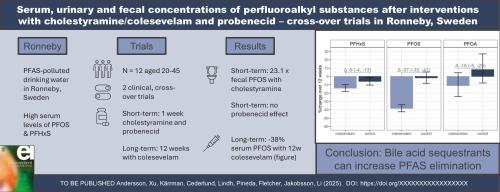Serum, urinary and fecal concentrations of perfluoroalkyl substances after interventions with cholestyramine/colesevelam and probenecid – cross-over trials in Ronneby, Sweden
IF 9.7
1区 环境科学与生态学
Q1 ENVIRONMENTAL SCIENCES
引用次数: 0
Abstract
Background
Some per- and polyfluoroalkyl substances (PFAS) such as perfluorohexane sulfonic acid (PFHxS), perfluorooctane sulfonic acid (PFOS) and perfluorooctanoic acid (PFOA) are very long-lived in humans, with serum half-lives of several years. In PFAS hot spots, such as Ronneby, Sweden, high exposures over time have led to markedly elevated serum PFAS levels, which may result in health risks as well as transfer to the next generation through pregnancy and breastfeeding. Bile acid sequestrants and organic anion transporter inhibitors are drug candidates for increasing PFAS elimination in humans.
Materials and methods
This is a cross-over, clinical study in 10 individuals from Ronneby, Sweden. First, participants were given the bile acid sequestrant cholestyramine and the organic anion transporter inhibitor probenecid for 1 week each. Urinary and fecal concentrations were measured prior, during and after the administration. Then, the changes of serum PFAS concentrations during a 12-week intervention with the bile acid sequestrant colesevelam were compared to a control period.
Results
The study population was mainly exposed to PFHxS (serum mean 50 ng/mL, range 5.8–170), PFOS (serum mean 46 ng/mL, range 9.2–130) and PFOA (serum mean 2.2, range 0.7–4.4). Cholestyramine intervention increased the serum adjusted fecal PFOS concentrations by 23.1 times (95 %CI: 13.6, 39.2), while probenecid was associated with 0.79 times (95 %CI 0.63, 1.0) serum-adjusted urinary PFOS concentrations, compared to no intervention. The 12-week intervention with colesevelam resulted in a mean serum PFOS decline of 38 % (95 %CI −42, −34), compared to 2 % (95 %CI −8, 5) in the control period. The decline was smaller for PFHxS and PFOA.
Conclusions
Bile acid sequestrants could be used for accelerating PFAS excretion in highly PFAS exposed individuals. Studies are needed to evaluate the risks, costs and benefits of using it for this purpose.


在瑞典Ronneby进行的抗胆胺/ colesevam和probenecid干预后全氟烷基物质的血清、尿液和粪便浓度的交叉试验
一些全氟烷基和多氟烷基物质(PFAS),如全氟己烷磺酸(PFHxS)、全氟辛烷磺酸(PFOS)和全氟辛酸(PFOA)在人体内的寿命非常长,血清半衰期可达数年。在PFAS热点地区,如瑞典Ronneby,长期大量接触PFAS已导致血清PFAS水平显著升高,这可能导致健康风险,并通过怀孕和哺乳转移给下一代。胆汁酸螯合剂和有机阴离子转运蛋白抑制剂是增加人体PFAS消除的候选药物。材料和方法这是一项交叉临床研究,研究对象是来自瑞典罗尼比的10个人。首先,参与者分别给予胆汁酸螯合剂胆甾胺和有机阴离子转运抑制剂probenecid 1 周。在给药前、给药期间和给药后分别测量尿液和粪便浓度。然后,将胆汁酸隔离剂colesevilam干预12周期间血清PFAS浓度的变化与对照期进行比较。结果研究人群主要暴露于PFHxS(血清平均值50 ng/mL,范围5.8 ~ 170)、PFOS(血清平均值46 ng/mL,范围9.2 ~ 130)和PFOA(血清平均值2.2,范围0.7 ~ 4.4)。与未干预相比,胆胺干预使血清调整后的粪便PFOS浓度增加了23.1倍(95 %CI: 13.6, 39.2),而probenecid使血清调整后的尿液PFOS浓度增加了0.79倍(95 %CI: 0.63, 1.0)。12周的colesevelam干预导致血清PFOS平均下降38% %(95 %CI−42,−34),而对照组为2% %(95 %CI−8,5)。PFHxS和PFOA的下降幅度较小。结论胆汁酸螯合剂可促进PFAS高暴露个体PFAS的排泄。需要进行研究,以评估为此目的使用它的风险、成本和效益。
本文章由计算机程序翻译,如有差异,请以英文原文为准。
求助全文
约1分钟内获得全文
求助全文
来源期刊

Environment International
环境科学-环境科学
CiteScore
21.90
自引率
3.40%
发文量
734
审稿时长
2.8 months
期刊介绍:
Environmental Health publishes manuscripts focusing on critical aspects of environmental and occupational medicine, including studies in toxicology and epidemiology, to illuminate the human health implications of exposure to environmental hazards. The journal adopts an open-access model and practices open peer review.
It caters to scientists and practitioners across all environmental science domains, directly or indirectly impacting human health and well-being. With a commitment to enhancing the prevention of environmentally-related health risks, Environmental Health serves as a public health journal for the community and scientists engaged in matters of public health significance concerning the environment.
 求助内容:
求助内容: 应助结果提醒方式:
应助结果提醒方式:


